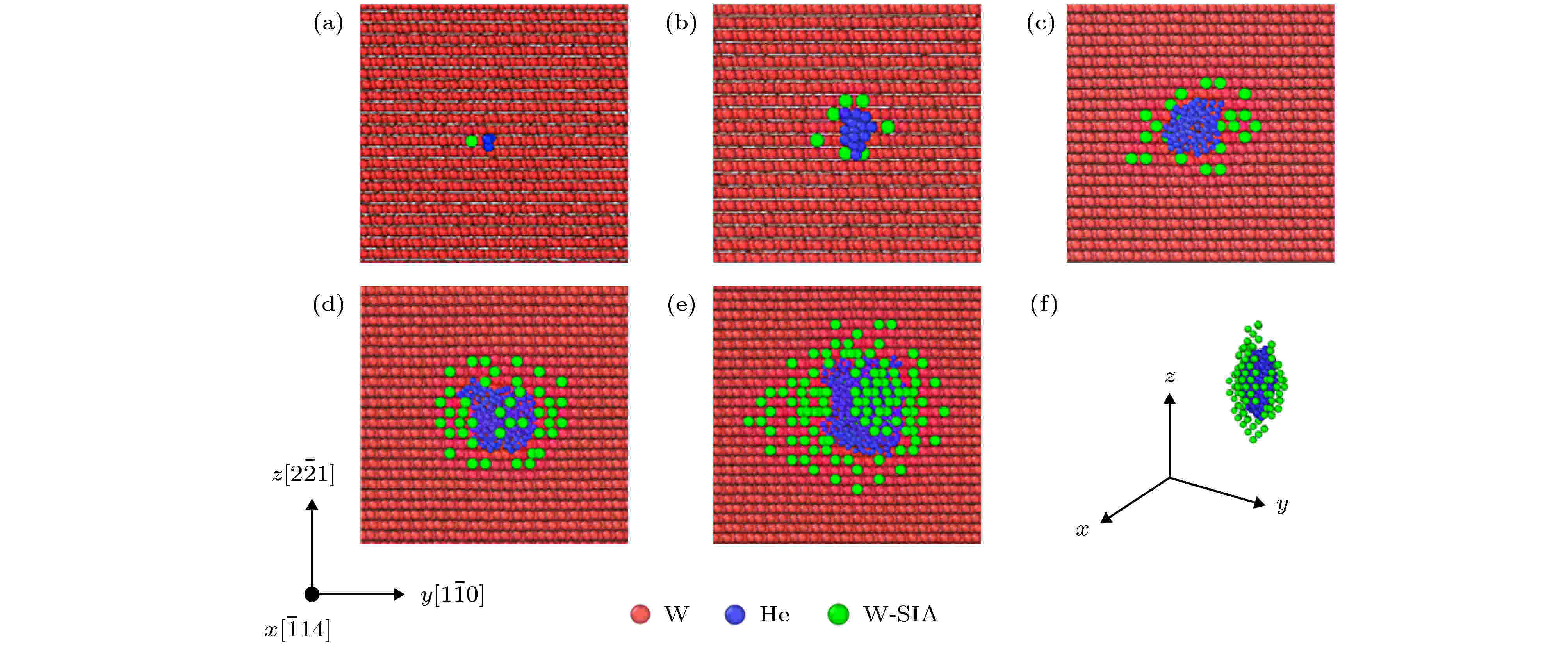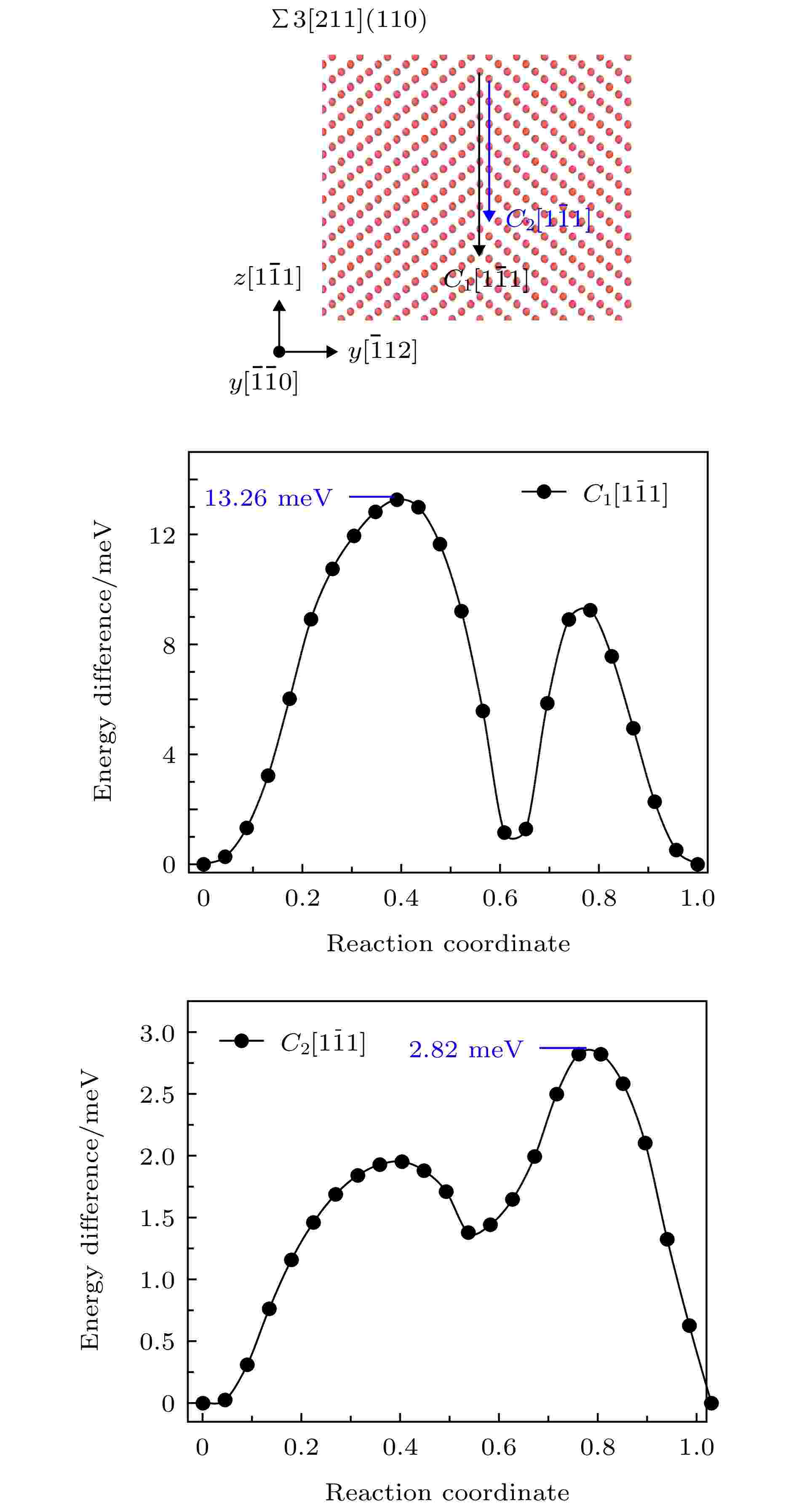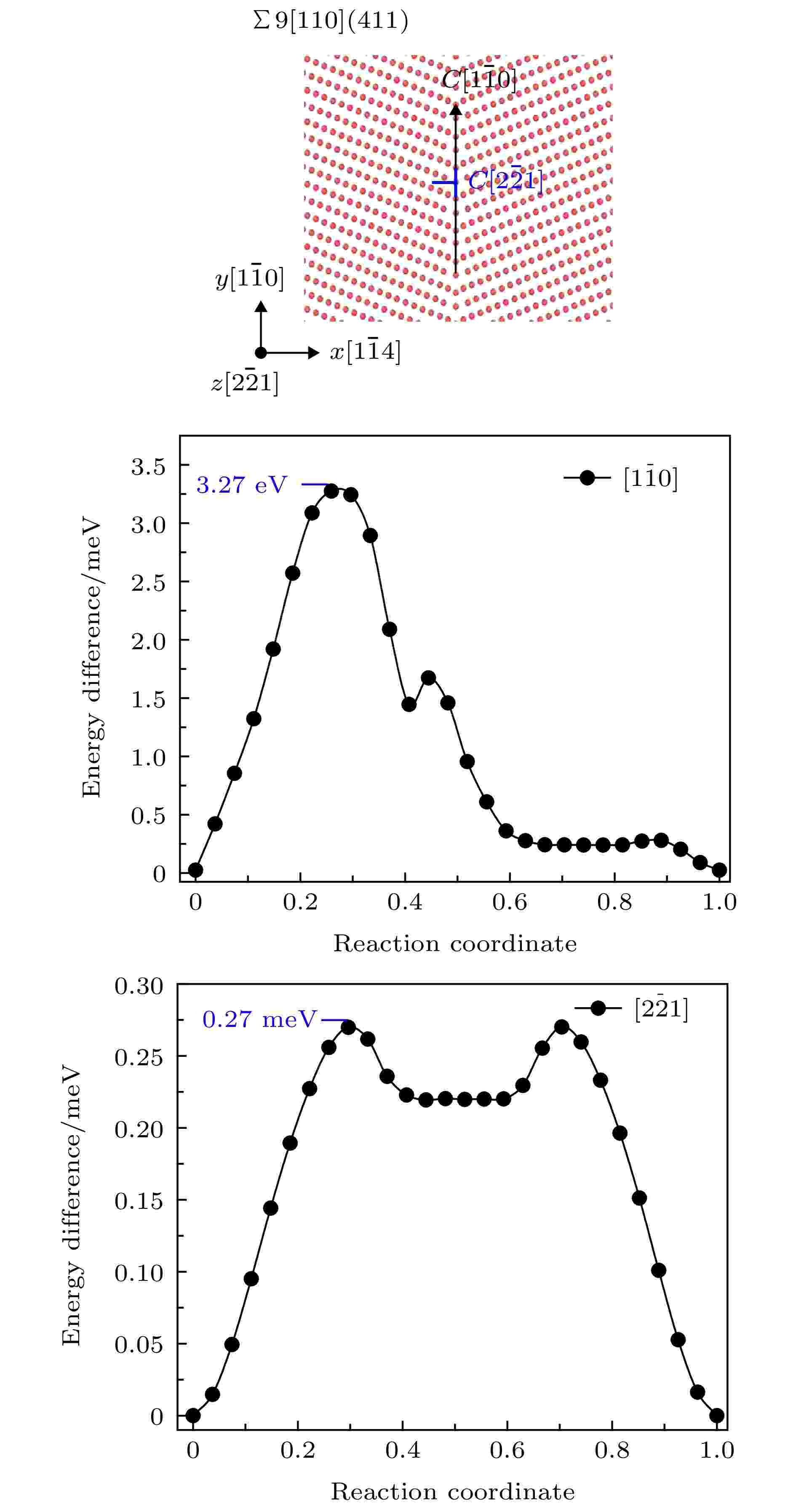全文HTML
--> --> -->He泡成核初期的直径较小, 一般在几个埃到几个纳米, 给采用实验方法研究其成核过程及生长机理带来了困难[10,11]. 因此, 理论模拟成为研究He泡成核长大机理的有效直观的工具, 例如用分子动力学模拟研究He泡的成核生长过程[12-16]. 近期Xie等[17]采用分子动力学方法模拟研究了He泡在单晶钨中的生长机理, 结果表明 He泡在成核长大的过程中会逐渐挤出W自间隙原子. 这些自间隙原子不断聚集在He泡表面形成1/2




另外, Yang等[19]采用分子动力学模拟研究He泡在bcc-Fe中的生长机制, 研究发现在bcc-Fe中∑3[110](112)和∑73b[110](661)倾斜对称晶界处He泡的成核长大机制各不相同. ∑3[110](112)晶界处, 随着He泡逐渐成核长大, 会有Fe自间隙原子不断被挤出并附着在He泡表面按[111]方向排列, 随着He泡进一步长大这些Fe自间隙原子会形成一个1/2

鉴于此, 我们通过逐个地将He原子加入到bcc-W中, 研究了He泡在单晶W中以及两个晶界∑3[211](110)和∑9[110](411)处的成核长大机制, 研究对控制He泡成核长大提供详细的理论参考与支撑. 应该指出的是, Zhao等[20]通过第一性原理研究了He原子在bcc-W中的溶解能以及结合能. 结果表明: He在bcc-W中具有较高的溶解能, 为6 eV左右; He与He在bcc-W中具有较高的结合能(大于1 eV). 因此, He可以在bcc-W自发的聚集成核. 同时, 引起He泡成核的可能机制有两种, 一种是空位或空洞引起的He泡成核机制, 另一种是由于He原子的局部富集. 本工作研究的重点是后一种情况, 以了解He原子的聚集和He泡成核长大初期的演化机制.
在分析过程中, 运用了Wigner-Seitz点缺陷分析方法分析W自间隙原子, 用Dislocation analysis (DXA) 分析方法分析位错[27]. 同时, 为了研究He泡在成核长大初期压强与半径随时间的演化趋势, 用(1)式计算He泡的压强, 用(2)式计算He泡的半径[28,29]. (1)式和(2)式中的 n 表示He泡中He原子个数, σαβ表示第 i 个He原子的局部应力分量, Ωi和V 表示通过Voro++程序[30]求得的第 i 个He原子的Voronoi原胞体积以及He泡中所有He原子的Voronoi原胞体积之和.
3.1.He泡在单晶W中及晶界处的成核长大演化过程
33.1.1.He泡在单晶W中的成核长大
为了研究He泡在晶界处的成核长大, 首先研究了He泡在单晶W中的成核长大. 如图1所示, 当模拟时间为0.072 ns时, 单晶W模拟盒子中有14个He原子聚集形成He团簇并在其周围并挤出1个W自间隙原子(W-SIA)(图1(a)). 随着He原子的继续加入, He团簇周围有更多的W自间隙原子挤出, 当He原子的个数增加到30时, He团簇周围有5个W自间隙原子聚集并沿[111]方向排列(图1(b)). 当模拟时间为0.256 ns时, He团簇中有51个He原子, 氦团簇周围有14个W自间隙原子, 并且这些W自间隙原子聚集形成了1/2



 图 1 单晶W中氦团簇成核长大初期的位错环发射过程
图 1 单晶W中氦团簇成核长大初期的位错环发射过程Figure1. The punching-loop at the early stage of nucleation and growth of helium clusters in bulk W
3
3.1.2.He泡在W中∑3[211](110)晶界处的成核长大
在∑3[211](110)晶界附近两个晶格常数范围内逐个引入He原子, 如图2所示, 当He原子的个数逐渐增加到8个时, 在晶界处聚集的He原子团簇挤出了一个格点W原子, 随后挤出的W自间隙原子附着在He团簇周围(图2(a)). 当模拟时间为0.120 ns时, 晶界上有24个He原子聚集形成团簇, 同时He团簇周围挤出了6个W自间隙原子, 并且这些W自间隙原子沿[111]方向在晶界上迁移出去随后到达表面(图2(b)). 随着模拟时间的增加, 又有W自间隙原子在He团簇周围聚集, 随后这些W自间隙原子会形成首尾位于晶界面上的1/2








 图 2 氦泡在W中∑3[211](110)晶界处的成核长大过程 (a) 0.043 ns, 8 He, 1 SIA; (b) 0.120 ns, 24 He, 6 SIAs; (c) 0.125 ns, 24 He, 6 SIAs; (d) 0.466 ns, 93 He, 21 SIAs; (e) 0.469 ns, 94 He, 22 SIAs; (f) 0.470 ns, 94 He, 22 SIAs
图 2 氦泡在W中∑3[211](110)晶界处的成核长大过程 (a) 0.043 ns, 8 He, 1 SIA; (b) 0.120 ns, 24 He, 6 SIAs; (c) 0.125 ns, 24 He, 6 SIAs; (d) 0.466 ns, 93 He, 21 SIAs; (e) 0.469 ns, 94 He, 22 SIAs; (f) 0.470 ns, 94 He, 22 SIAsFigure2. The nucleation and growth of helium clusters at grain boundary ∑3[211](110) in W: (a) 0.043 ns, 8 He, 1 SIA; (b) 0.120 ns, 24 He, 6 SIAs; (c) 0.125 ns, 24 He, 6 SIAs; (d) 0.466 ns, 93 He, 21 SIAs; (e) 0.469 ns, 94 He, 22 SIAs; (f) 0.470 ns, 94 He, 22 SIAs
3
3.1.3.He泡在W中∑9[110](411)晶界处的成核长大
图3为He泡在∑9[110](411)晶界处的成核长大动力学演化过程, 图3(a)—图3 (e)截图均位于晶界面上. 如图3(a), 当∑9[110](411)晶界处有3个He原子聚集形成团簇后可以挤出一个W间隙原子, 随着氦原子的加入个数逐渐增多, 会有更多的W间隙原子挤出到He团簇周围, 并且这些W间隙原子成包覆状聚集在He团簇周围, 如图3(e)和图3 (f)所示, 在2 ns时由氦团簇长大挤出的W自间隙已经He团簇表面形成一层W自间隙原子包壳. 并且, 在我们的模拟时间尺度范围内没有观察到自W间隙子的发射和位错的挤出. 图 3 氦泡在W中∑9[110](411)晶界处的成核长大过程 (a) 0.02 ns, 3 He, 1 SIA; (b) 0.1 ns, 19 He, 7 SIAs; (c) 0.5 ns, 99 He, 23 SIAs; (d) 1 ns, 199 He, 44 SIAs; (e) 2 ns, 399 He, 121 SIAs; (f) 2 ns
图 3 氦泡在W中∑9[110](411)晶界处的成核长大过程 (a) 0.02 ns, 3 He, 1 SIA; (b) 0.1 ns, 19 He, 7 SIAs; (c) 0.5 ns, 99 He, 23 SIAs; (d) 1 ns, 199 He, 44 SIAs; (e) 2 ns, 399 He, 121 SIAs; (f) 2 nsFigure3. The nucleation and growth of helium clusters at grain boundary ∑9[110](411) in W: (a) 0.02 ns, 3 He, 1 SIA; (b) 0.1 ns, 19 He, 7 SIAs; (c) 0.5 ns, 99 He, 23 SIAs; (d) 1 ns, 199 He, 44 SIAs; (e) 2 ns, 399 He, 121 SIAs; (f) 2 ns
2
3.2.W自间隙原子在单晶W以及晶界处的迁移能垒
为了解释3.1中的现象, 我们用Nudged Elastic Band(NEB)方法计算了W自间隙原子在单晶W中以及晶界处的迁移能垒. 对与单晶W中以及∑3[211](110)晶界处, 从本文3.1.1和3.1.2节可知, He泡挤出的W自间隙原子以及位错是按[111]方向迁移的. 因此, 本文对于这两个体系, 计算了W自间隙原子沿[111]方向的迁移能垒. 图4为单晶W中W自间隙原子沿[111]方向迁移的能垒曲线, 得出单晶W中W自间隙原子的迁移能垒为5.8 meV, 该结果与第一性原理计算值4 meV符合较好[31]. 图5为W中∑3[211](110)对称倾斜晶界处, W自间隙原子沿晶界面上[111]方向(C1[111])和最邻近晶界面上[111]方向(C2[111])迁移的过渡态曲线, 从而得出W自间隙原子沿C1[111]方向和C2[111]的迁移能垒分别为13.26和2.82 meV. 图 4 单晶W中自间隙原子的迁移能垒
图 4 单晶W中自间隙原子的迁移能垒Figure4. Calculation of the migration barrier for a W crowdion defect in bulk W
 图 5 W中∑3[211](110)晶界处W自间隙原子的迁移能垒
图 5 W中∑3[211](110)晶界处W自间隙原子的迁移能垒Figure5. Calculation of the migration barrier for a W crowdion defect at grain boundary ∑3[211](110) in W
而∑9[110](411)晶界处, 在我们的模拟时间尺度范围内没有观测到W自间隙原子的迁移和位错的挤出(见本文3.1.3节), 并且W自间隙原子在∑9[110](411)晶界附近存在偏聚行为[32]. 因此我们在晶界面上找出了两条W自间隙原子迁移能垒分别位次最小和最小的方向, 分别为[


























 图 6 W中∑9[110](411)晶界处的自间隙原子的迁移能垒
图 6 W中∑9[110](411)晶界处的自间隙原子的迁移能垒Figure6. Calculation of the migration barrier for a W crowdion defect at grain boundary ∑9[110](411) in W
从上面的W自间隙原子在不同结构中的迁移能垒可以得出: 单晶W中和∑3[211](110)晶界处He泡周围的W自间隙原子的迁移能垒只有几个到十几个毫电子伏特, 在热弛豫过程中只要W自间隙原子从He泡表面解离就很容易迁移出去; ∑9[110](411)晶界处W自间隙原子的迁移能为零点几个到几个电子伏特, 即使热弛豫过程当中W自间隙原子从He泡表面解离也很难迁移出去. 因此, 我们在单晶W中和∑3[211](110)晶界处观察到了W自间隙子和位错的挤出与发射. 而在∑9[110](411)晶界处He泡挤出的W自间隙原子则是在He泡表面形成一层包壳.
2
3.3.W自间隙原子在单晶W以及晶界处氦泡的压强与半径随时间的演化
从图7(a)—图7 (c)W自间隙原子在单晶W以及晶界处氦泡的压强与半径随时间的演化可以得出: He泡在单晶W和∑3[211](110)晶界处成核长大演化过程初期压强较高, 并随着He原子的不断加入而快速下降并趋于稳定; 而在∑9[110](411)晶界处氦泡的压强在He原子引入初期就已经趋于稳定. 对于这种现象, 通过计算单晶W中和晶界处弗伦克尔缺陷对的形成能得到解释. 如表1所列, 在单晶W中和∑3[211](110)晶界处弗伦克尔缺陷对的形成能分别为14.10 eV(与文献[33]结果14.10 eV一致)和12.73 eV, 而∑9[110](411)晶界处弗伦克尔缺陷对的形成能为3.84 eV. 因此, ∑9[110](411)晶界处弗伦克尔缺陷形成能较低, 当氦原子的加入后较容易形成W自间隙原子, 近而释放氦泡成核初期的压力.| 缺陷位置 | 弗伦克尔缺陷对的形成能/eV |
| 单晶W中 | 14.10 |
| ∑3[211](110)晶界处 | 12.73 |
| ∑9[110](411)晶界处 | 3.84 |
表1单晶W及晶界处弗伦克尔缺陷对的形成能
Table1.Formation energy of frenkel defect pair in bulk W and at grain boundaries.
 图 7 (a)单晶W中氦泡的压强与半径随时间的变化; (b) ∑3[211](110)晶界处氦泡的压强与半径随时间的变化; (c) ∑9[110](411)晶界处氦泡的压强与半径随时间的变化
图 7 (a)单晶W中氦泡的压强与半径随时间的变化; (b) ∑3[211](110)晶界处氦泡的压强与半径随时间的变化; (c) ∑9[110](411)晶界处氦泡的压强与半径随时间的变化Figure7. (a) The radius and pressure of the He bubble as a function of simulation time in bulk W; (b) the radius and pressure of the He bubble as a function of simulation time at at grain boundary ∑3[211](110); (c) the radius and pressure of the He bubble as a function of simulation time at at grain boundary ∑9[110](411)
同时, 不管是单晶W中还是∑3[211](110)和∑9[110](411)晶界处, 当氦泡的压强随时间趋于稳定后, 每当压强出现骤降, 氦泡的半径都会迅速增加, 从而在氦泡半径随时间演化的曲线上形成小台阶. 因此, 氦泡在W中可以通过间歇性释放压力来促进生长.
1)晶界处氦泡的长大机制和单晶W中有所不同. 单晶W中氦泡通过挤出位错环促进长大. 而∑3[211](110)晶界处氦泡通过先挤出并发射少量自间隙W原子, 而后挤出1/2

2)氦泡在单晶W和∑3[211](110)晶界处成核长大演化过程初期压强较高, 随着氦原子的不断加入而快速下降并趋于稳定; 而在∑9[110](411)晶界处, 氦泡的压强在其成核长大演化过程初期就已经趋于稳定, 这是由于∑9[110](411)晶界处弗伦克尔缺陷形成能较低, 随氦原子的加入较容易形成W自间隙原子, 从而释放氦泡成核初期形成的压力;
3)氦泡在W中可以通过间歇性释放压力来促进生长.
感谢中国科学院近代物理研究所先进核能材料研究室高宁研究员给出的意见和帮助.


